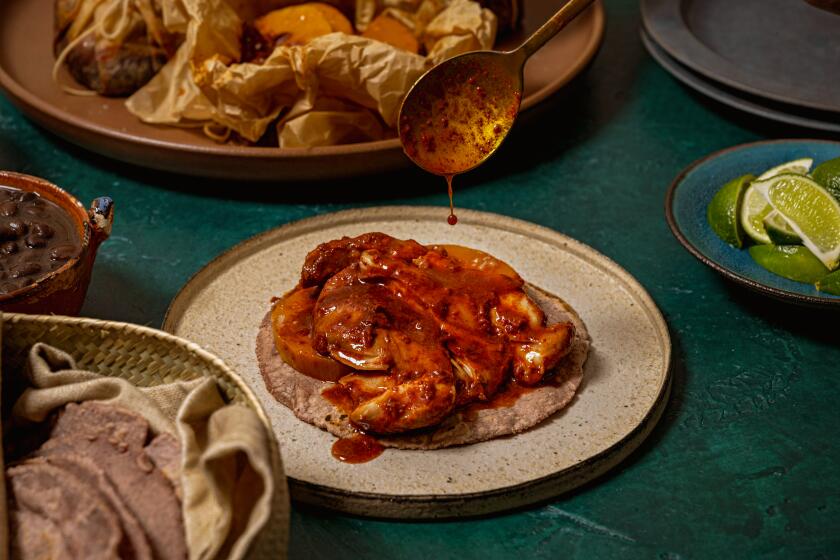Miso Soup With Chicken and Vegetables

- Share via
My 16-year-old son thinks his American breakfast is not complete without miso soup. He dips his toast in the soup, which is something I have never seen a Japanese do, but he says it’s delicious.
My own mother never made miso soup for breakfast even though it is part of a traditional breakfast in Japan. She spent her girlhood in wartime Japan, dreaming of someday owning a big GE refrigerator stocked with butter and cream. So when she moved to America with my father and their five children, breakfast often consisted of steamed rice with melted butter on top and tall glasses of whole milk.
In the ‘70s, my mother got nostalgic for Japanese foods, especially miso. One day, she bought a bag of dried soybeans, soaked the beans overnight, cooked them and blended them to make a mushy white paste. She added salt and koji, a miso starter made from fermented rice, and created a huge mess in the kitchen.
The resulting miso was kept it in a lidded clay jar in the cool and dark corner of the garage for years. We used to sneak in there and stick in fingers to lick the thick, grainy paste that looked like mud. Later, when I was much older, I realized I was snacking on a very healthy food, maybe a bit salty, but still full of protein.
Miso soup’s main ingredient, miso paste, is made mostly from soybeans-”meat from the fields” as the Japanese have called it for centuries. Miso contains high levels of protein and more Vitamin B, Vitamin E, calcium and iron than beef, not to mention that it is low in fat and cholesterol. So it makes an ideal base for a healthy soup.
There are thousands of types of miso, which in Japan enjoys a mystique almost like wine in France. Miso, too, is fermented for at least a year, often as long as three years.
Also like wine, miso paste comes in red and white varieties. Red (aka) miso pastes like sendai and haccho are dark brown in color, and robust in flavor. White (shiro) miso pastes like saikyo are yellow in color, lighter and sweeter than red miso paste.
Some miso pastes such as inaka miso, koji miso and mugi miso incorporate grains of wheat, rice, barley or soybeans to create a variety of textures and tastes.
For me, the ultimate use of miso is in a soup. My mother’s theory of miso soup is to fill the bowl with a variety of vegetables from the land and sea-so full that you can stand a pair of chopsticks in the bowl.
You can experiment with different types of miso pastes. Some are saltier than the others, so when making miso soup, always taste the soup and make adjustments. I have four or five different miso pastes in my fridge at all times. I let my whim dictate which goes into the soup.
Even without toast, miso soup is not for the doctrinaire.
Heat the oil in a nonstick saucepan over medium heat and cook the chicken, potato, daikon and carrot 1 minute. Add the Dashi and cook over high heat until the vegetables are tender but still firm, 3 minutes. Reduce the heat to a simmer.
In a small bowl, dissolve the red miso and 1 1/2 tablespoons saikyo miso with a few tablespoons of the hot Dashi, and add the mixture to the saucepan, along with the tofu. Taste the soup and add more miso paste, Dashi or water, depending on how strong it tastes.
Pour the soup into serving bowls, sprinkle each bowl with the chopped green onion, ginger and sesame seeds and serve at once.
Get our Cooking newsletter
Get a taste of Los Angeles — and the world — with recipes and kitchen tricks from the L.A. Times’ Cooking newsletter.
You may occasionally receive promotional content from the Los Angeles Times.















